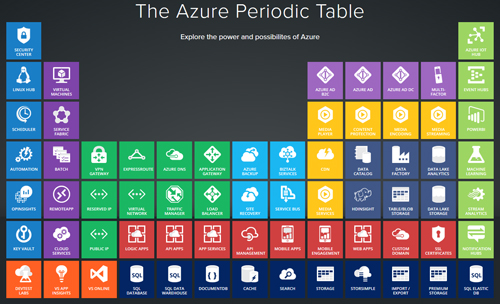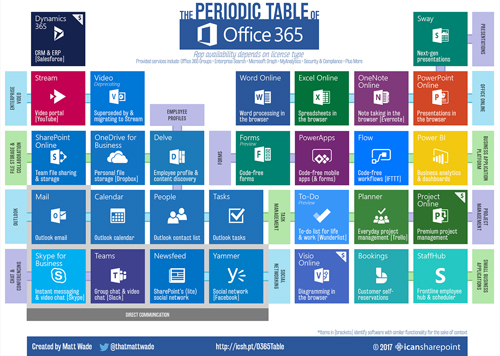News
To Explain Microsoft's Cloud Stacks, Partners Use Periodic Tables
It's elementary.
- By Barb Levisay
- July 26, 2017
Those who said the cloud would simplify technology marketing sure got it wrong.
The proliferation of applications within cloud stacks combined with the democratization of tech has created a billowing matrix of solutions that need to be explained to multiple audiences.
Fortunately, with a channel full of creative people all thinking about the same challenge, clever ways to simplify the complexities of the cloud are bound to emerge. Like the two creative partners borrowing from the field of chemistry to illustrate how applications and services can be combined to support business process and outcomes.
For the Concurrency Inc. marketing team, the inspiration for the Azure Periodic Table came during a brainstorming session. The team was trying to come up with a way to explain the Azure stack in terms both IT and business decision makers could understand. The comment, "It's kind of like a science," sparked ideas that led to the periodic table approach and a whole science fair-themed campaign.
 [Click on image for larger view.] Concurrency's "Azure Periodic Table." (Source: Concurrency Inc.)
[Click on image for larger view.] Concurrency's "Azure Periodic Table." (Source: Concurrency Inc.)
"We basically created what is now an Azure science fair where we discuss multiple topics around Azure, we present the Azure periodic table and we have a lot of fun with it," says Ted Wentzel, director of marketing at Concurrency. "It's an interesting way to help people understand how broad Azure is."
On the Azure Periodic Table Web page, visitors hover over the elements for deeper descriptions. As the next step, "compounds" of elements will explain how services can be combined to support specific outcomes. While the periodic table concept helps to engage and simplify conversations, the messaging fits well with Concurrency's current focus on helping customers make the digital transformation.
"It pairs very closely with our message to help organizations digitally transform their business," says Nathan Lasnoski, Concurrency's CTO. "The building blocks of the traditional IT market had been servers and infrastructure, layering on applications and building these sort of monolithic applications. Sometimes when people think about moving to the cloud, they think about just lifting and shifting that existing infrastructure into a cloud domain."
Concurrency's cloud messaging is aimed at helping customers understand that digital transformation is far more than a different place for infrastructure to sit. "When we talk about how an organization can transform an area of the business, we talk about using new sets of capabilities that have changed the way we develop applications, deliver infrastructure and interact with our customers through mobile applications or IoT," says Lasnoski. "The periodic table has provided us with a great conversation piece to expose those capabilities and apply the innovation curve that can help organizations serve their ultimate customers better."
For Matt Wade, cloud services lead at H3 Solutions Inc., the challenge was explaining how all of the components of Office 365 fit together as a cohesive solution. "One of the biggest confusion points is, simply, what is Office 365? I don't think that's very well-defined, and when you go searching for it you're going to get hundreds of posts that say different things -- often aimed at IT pros instead of users," Wade says. "Pictures speak thousands of words, and I think it's absolutely true. This might be your Rosetta Stone to understanding how to put Office 365 to work."
 [Click on image for larger view.] The "Office 365 Periodic Table" by Matt Wade. (Source: Matt Wade)
[Click on image for larger view.] The "Office 365 Periodic Table" by Matt Wade. (Source: Matt Wade)
Wade's Office 365 Periodic Table uses the two-dimensional approach to help both technology pros and business users see the layered connections of productivity apps. "The two-axis system really helped out, because it gave me a way to group things in a horizontal way, but also position things on top or bottom to elements that might connect in different ways. For example, I put People from Outlook as part of the Outlook grouping, but People also covers people profiles, or employee profiles."
Wade's Office 365 Periodic Table is annotated to provide additional clues and comparable products to help readers understand the function of each application element.
Based on the positive feedback and number of requests both organizations have received to use their periodic tables in presentations, the approach resonates with the channel. Partners, MVPs and Microsoft employees all see the tables as a logical way to explain the complexities of the cloud to IT pros and business users alike. As is the case with most partners, they want the community to use and build on their ideas while respecting intellectual property rights and appropriate source credit.
The strength of the partner channel shines through with every new challenge. Perhaps it's fitting, as we venture out into the new world of cloud-fueled digital transformation, that we step it back to the foundational elements to explain how it's all going to work together. Leave it to clever partners to sort through the details and deliver the big picture.
About the Author
Barb Levisay owns Marketing for Partners, a marketing and service delivery leadership firm for Microsoft Dynamics, SharePoint and ISV partners. She serves as the event chair on the Board of Directors for the Washington, D.C., chapter of the International Association of Microsoft Channel Partners.